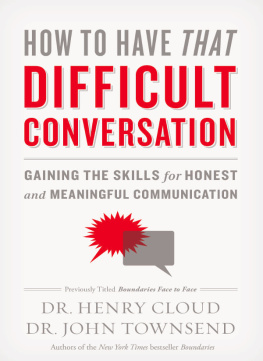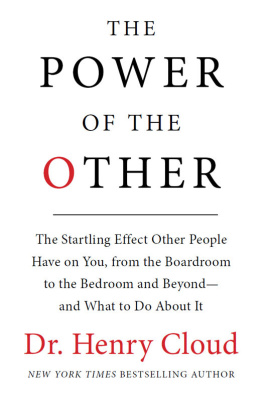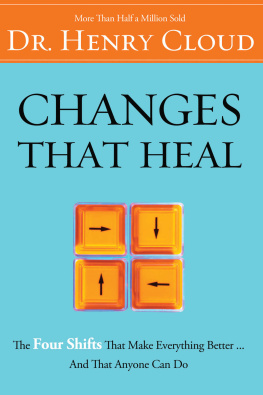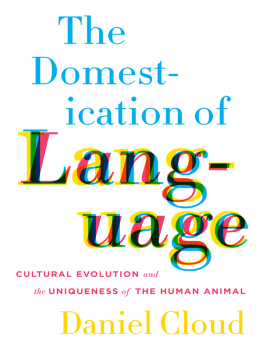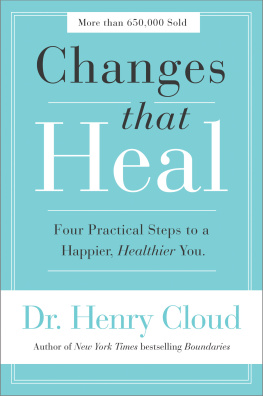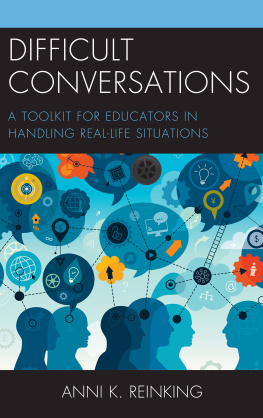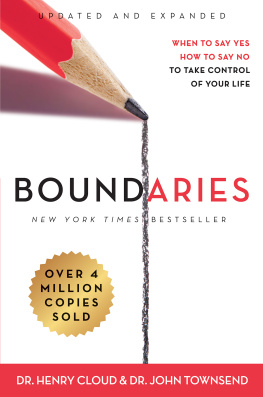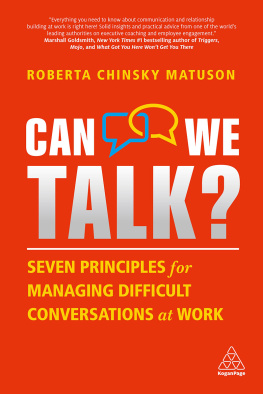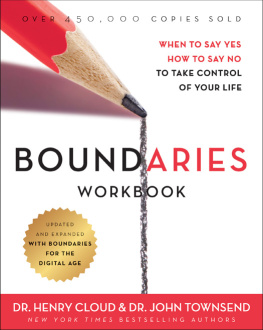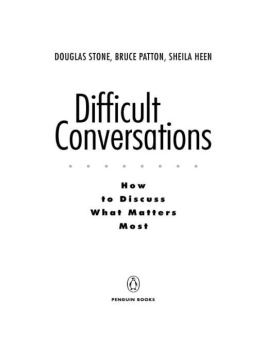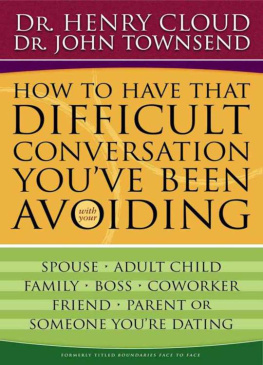
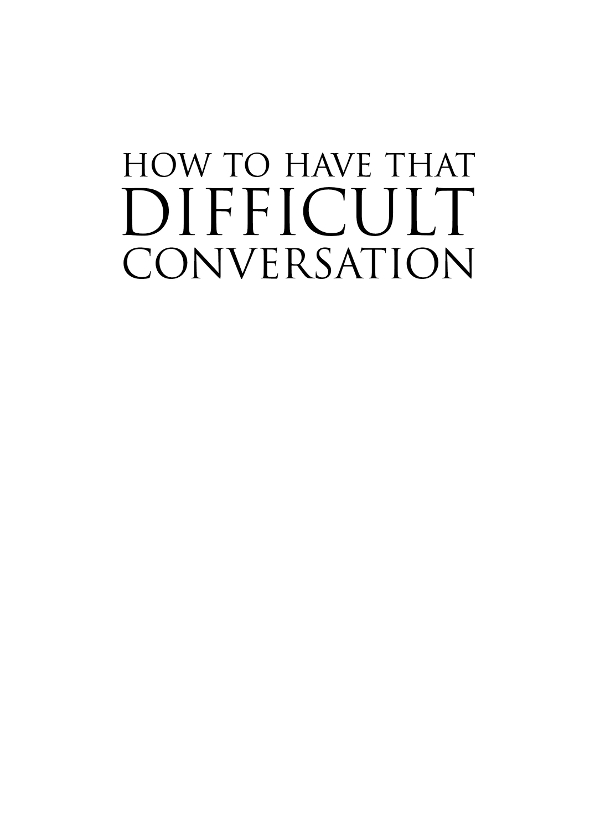
Resources by Henry Cloud and John Townsend
Books
Boundaries (and workbook)
Boundaries in Dating (and workbook)
Boundaries in Marriage (and workbook)
Boundaries with Kids (and workbook)
Boundaries with Teens (Townsend)
Changes That Heal (and workbook) (Cloud)
Hiding from Love (Townsend)
How People Grow (and workbook)
How to Have That Difficult Conversation
Making Small Groups Work
Our Mothers, Ourselves (and workbook)
Raising Great Kids
Raising Great Kids Workbook for Parents of Preschoolers
Raising Great Kids Workbook for Parents of School-Age Children
Raising Great Kids Workbook for Parents of Teenagers
Safe People (and workbook)
12 Christian Beliefs That Can Drive You Crazy
Video Curriculum
Boundaries
Boundaries in Dating
Boundaries in Marriage
Boundaries with Kids
Raising Great Kids for Parents of Preschoolers
ReGroup (with Bill Donahue)
Audio
Boundaries
Boundaries in Dating
Boundaries in Marriage
Boundaries with Kids
Boundaries with Teens (Townsend)
Changes That Heal (Cloud)
How People Grow
How to Have That Difficult Conversation
Making Small Groups Work
Our Mothers, Ourselves
Raising Great Kids
ZONDERVAN
How to Have That Difficult Conversation
Copyright 2003, 2005 by Henry Cloud and John Townsend
Previously published as: How to Have That Difficult Conversation Youve Been Avoiding
Requests for information should be addressed to:
Zondervan, 3900 Sparks Dr. SE, Grand Rapids, Michigan 49546
ePub Edition July 2015: ISBN 978-0-310-34380-6
Library of Congress Cataloging-in-Publication Data
Cloud, Henry.
[Boundaries face to face]
How to have that difficult conversation youve been avoiding : with your spouse, your adult child, your boss, your coworker, your best friend, your parent, someone youre dating / Henry Cloud and John Townsend. 1st ed.
p. cm.
Originally published: Boundaries face to face. Grand Rapids, Mich. : Zondervan, c2003. With discussion guide.
ISBN 978-0-310-26714-0
I. Townsend, John Sims, 1952 II. Title.
BV4597.53.C58C59 2006
158.2 dc22
2005027779
All Scripture quotations, unless otherwise indicated, are taken from the Holy Bible, New International Version. NIV. Copyright 1973, 1978, 1984, 2011 by Biblica, Inc. Used by permission of Zondervan. All rights reserved worldwide. Italics in Scripture quotations are added by the authors for emphasis.
Scripture quotations marked NASB are from the New American Standard Bible, Copyright 1960, 1962, 1963, 1968, 1971, 1972, 1973, 1975, 1977 by The Lockman Foundation.
Any Internet addresses (websites, blogs, etc.) and telephone numbers in this book are offered as a resource. They are not intended in any way to be or imply an endorsement by Zondervan, nor does Zondervan vouch for the content of these sites and numbers for the life of this book.
All rights reserved. No part of this publication may be reproduced, stored in a retrieval system, or transmitted in any form or by any means electronic, mechanical, photocopy, recording, or any other except for brief quotations in printed reviews, without the prior permission of the publisher.
Published in association with Yates & Yates, www.yates2.com.
Interior design: Beth Shagene
First printing June 2015
To all those who seek to make truthful conversations a central part of all their relationships.
Contents
PART I
WHY YOU NEED TO HAVE THAT DIFFICULT CONVERSATION
PART II
THE ESSENTIALS OF A GOOD CONVERSATION
PART III
SEEING HOW ITS DONE
PART IV
GETTING YOURSELF READY TO HAVE THE CONVERSATION
PART V
HAVING THE DIFFICULT CONVERSATION WITH PEOPLE IN YOUR LIFE
S ealy Yates, our agent, for his own commitment to truth and love.
Scott Bolinder, our publisher, for supporting and partnering with us in this work.
Sandy Vander Zicht, our editor, for her expertise and her genuine care about seeing people grow and mature.
Maureen Price, director of Cloud-Townsend Resources, for her appreciation for the value of boundaries face-to-face.
Denis Beausejour, director of Answers for Life, for his vision and commitment to the process of helping others find Christ and experience the life Christ designed.
The attendees of Monday Night Solutions in Irvine, California, for their faithfulness in seeking God and helping us develop the concepts that ended up in this book.
W e never foresaw how well our book Boundaries: When to Say Yes, When to Say No to Take Control of Your Life was going to do. Although we knew through our clinical work that many people identify with the need to regain control of their lives, we had no idea how widespread that need was. Almost everyone feels the need for better boundaries at one time or another.
Sometimes we need to deal with a difficult person in a relationship, such as a controller, a manipulator, or someone who is irresponsible or even abusive. At other times we need to figure out what demands of life to say no to so we wont overextend ourselves. At still other times we need to work out better patterns of intimacy and relatedness in a good relationship, or take a stand for our values in a difficult one. Still other times, we might need to keep someone from taking over more of our time, energy, and resources than we would like to give. There are many, many different contexts of life in which we need to exercise good boundaries. For people who care, setting those boundaries can be tough. So it really is no surprise that Boundaries has found such a ready audience.
As a result of the books following, we find ourselves speaking to tens of thousands of people directly every year and literally millions through our radio program. When we talk to people, the theme of dealing with difficult relationships continues to surface. Resolving relational issues is always on the forefront of peoples minds.
As we answer questions, we find ourselves continually telling people that they should have a direct conversation with the person with whom they have the problem. They repeatedly say either, Ive tried that, and it didnt work, or, How would I do that? Either they have tried and found themselves overpowered or outmaneuvered, or they just dont know how to broach such a conversation. So we often tell them to role-play with us. We say, You be him or her and Ill be you. Now go. When we show them how to have such a conversation, the lights go on for the first time. They often say things like I never thought about saying it like that. That makes all the difference in the world. Now I know what to do.
Many people in the audience who observe the role-playing tell us the same thing. Just hearing how to do it gives them a process to follow, and they can go forward with more confidence that they will be able to resolve a tough issue.
This book shows readers how to do that, how to have a boundary conversation. Most people know that they need to set boundaries with someone or have a difficult conversation with someone, but few know how to do it well. Some are so afraid, they never try; others try and fail dismally; still others do it in a way that does more harm than good. For that reason, people put off confronting, setting boundaries, or facing into difficult conversations. As a result, their relationships suffer.
Next page
